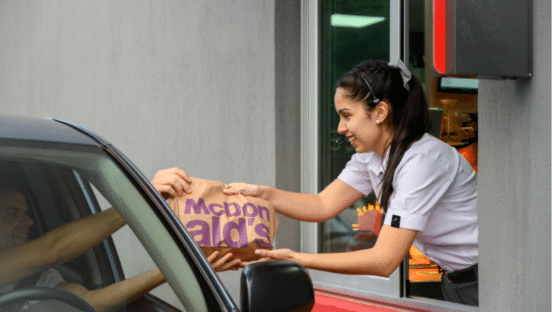In the first quarter, Papa John’s notched its sixth straight period where same-store sales outperformed the pizza industry, and the seventh straight quarter of positive global sales growth. Average weekly sales per restaurant continue to set new records in North America.
This phenomenon can be easily explained, CEO Rob Lynch said. The 26.2 percent rise in North American comp sales and the 23.2 percent lift in international stores is a result of company purpose, core values, and a strategic plan that were put in place in mid-2019.
A vital pillar of that strategic plan has been to continually innovate against every facet of the business, like the growth of digital—a channel that’s still skyrocketing because of COVID. Papa John’s added nearly 11 million new customers on digital channels alone in the past year, pushing the total number of loyalty users to 20 million. The chain is able to engage customers with targeted offers that drive more transactions through higher frequency and fuel incremental ticket, which in turn creates higher margins.
Digital mixed more than 70 percent in Q1 compared to 62 percent two years ago. It makes sense why Papa John’s is so good at cultivating its online presence—it’s been working at it since 2001, back to the days of scratchy dial-up internet noises. These digital channels facilitate impactful loyalty programs, Lynch said. A growing share of digital transitions, now nearing 50 percent, come from Papa Rewards loyalty members.
“In addition to higher transaction sizes and gross margins associated with better targeting of offers and promotions, loyalty members are also more engaged and much more likely to be repeat customers,” Lynch said during the chain’s Q1 earnings call. “ … Our frequency among current customers outside of the loyalty program has remained relatively flat. Our frequency among our loyalty program customers has increased.”
READ MORE: Papa John’s Pivots to Global Growth
Papa John’s is also leveraging technology through integrated partnerships with third-party delivery companies. Lynch said the relationships bring incremental and profitable transactions. Sales through aggregators increased 5x year-over-year in the first quarter, which contributed a “sizable and accelerating” portion of North America’s comp sales performance.
In regard to these third parties, Lynch said the strategy is simple—Papa John’s wants to be where the customers are.
“We have said in the past that we believe the incrementality of that business is between 60 and 65 percent,” Lynch said. So those are a lot of new customers that we wouldn’t have gotten had we not entered into these partnerships.”
The growth of delivery is the main reason why Lynch isn’t concerned with a lower carryout mix—something that Domino’s is intently focused on growing at the moment.
“I don’t know why that would be a disadvantage,” Lynch said. “The aggregators are growing at 100 percent. Delivery is becoming a much bigger part of the industry, and we’re one of the top delivery operators in the country. So we offer carryout, we support our carryout business, but we’re not pushing customers into carryout by discounting our carryout business. I mean that’s the biggest difference. It’s not like we don’t offer the same level of service of carryout as everyone else. We’re just not going to discount our product.”
[image source_ID=”128406″]
Papa John’s other vital source of innovation is its menu. In Q1, the big hit was the Epic Stuffed Crust pizza, which launched at the end of December. The product, mostly used by new customers, exceeded expectations. Lynch said culinary innovation is positively impacting international business as Papa John’s leverages its worldwide scale by sharing successful ideas across the network. For example, after the launch of Papadias, an add-on that’s proved incremental, the chain decided to roll out the innovation to 25 international markets early in 2021. The Epic Stuffed Crust pizza and Papadias are built on a premium platform, and that means Papa John’s is relying less on discounting to engage customers. This has led to better margins and higher unit level economics, Lynch noted.
Epic Stuffed Crust has been so successful that it’s prevented new innovation from hitting the market. As Lynch said, it wouldn’t be a good strategy to pull the plug on something that’s doing that well. It actually gives Papa John’s the luxury of continuing to build the innovation pipeline without needing it. Although he won’t disclose specifics, Lynch assured that more innovation is on the way in 2021.
“We had already planned to have launched new innovation already this year, but when you’re doing the kind of sales that we’re doing and it’s being driven by an initiative that you’re promoting, it’s really hard to take that thing off of promotion,” Lynch said. “So we are looking at a lot of different models, whether it is bringing a new item in the short-term or launching a new platform over a bit of a longer term or potentially moving into a space where we really haven’t been before where we’re promoting two items at once. We have the innovation, it’s ready to go, we’re really excited about it.”
READ MORE: Papa John’s Envisions ‘Historical Levels’ of Growth in 2021
Papa John’s, however, isn’t immune to the growing labor crisis hitting the restaurant industry. Lynch said the brand has always done its best to serve as an “employer of choice” at the corporate and store level, and it’s working with franchisees to do the same. The CEO noted that the primary gap in labor is with delivery drivers, and the best way to resolve that is higher sales in restaurants because that means more volume and higher wages for drivers. Lynch said Papa John’s drivers earn “significantly more” than the average minimum wage—a pretty decent retention tool for the brand. Leaning on third-party delivery drivers had relieved pressure, as well.
Papa John’s has also provided frontline bonuses and healthcare benefits to keep workers.
“Our goal is to continue to be an employer of choice, and treat our employees the way that’s consistent with maintaining them,” Lynch said. “In terms of going out and getting more, we could hire 10,000 more employees right now, so we’re always looking for great talented people who want to come and be a part of something that’s growing and something where we have been taking care of these communities for the last year, and a lot of our employees take pride in that.”
Based on Q1’s strength and strong sales in April, Papa John’s projects that it will deliver flat to slightly positive comps in North America in Q2. And that’s with markets reopening and a lap of double-digit comps growth a year ago.
Total revenues in Q1 increased 24.9 percent to $511.7 million. Net income increased to $33.9 million, or $0.82 diluted earnings per share, compared to $8.4 million, or $0.15 diluted earnings per share, in 2020. Operating income lifted from $15.5 million to $46.9 million this year.





